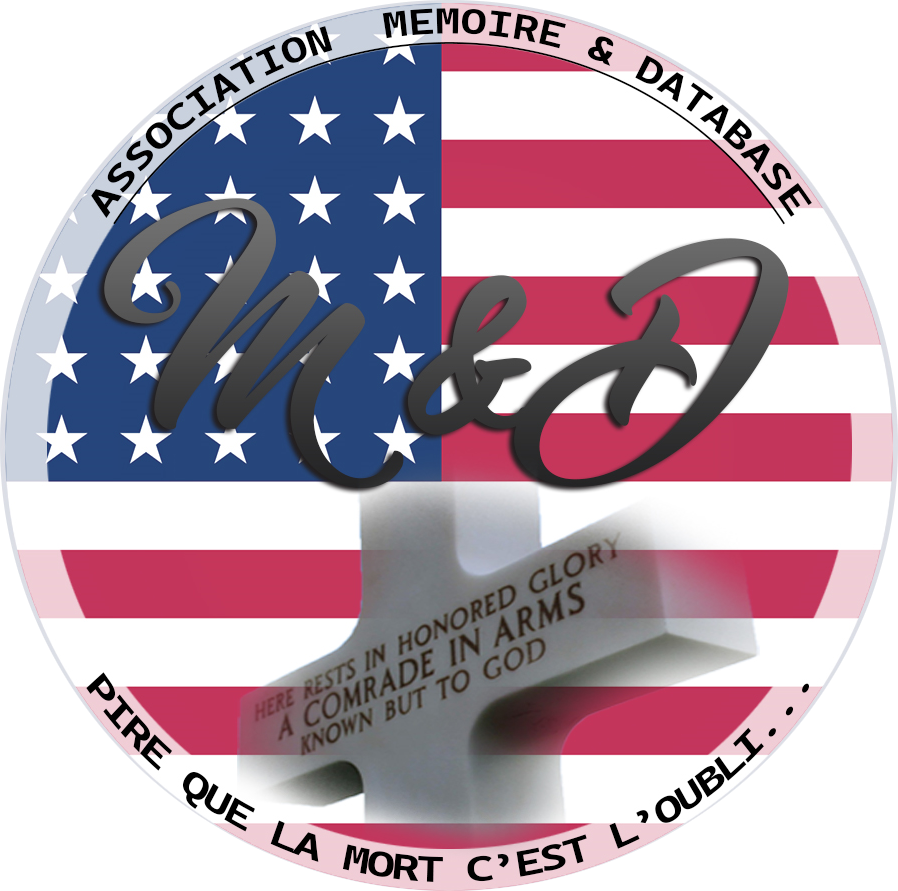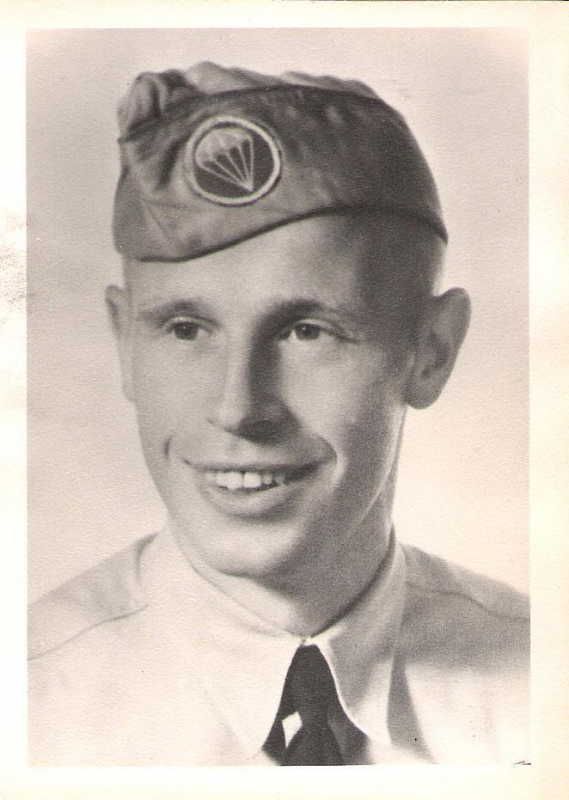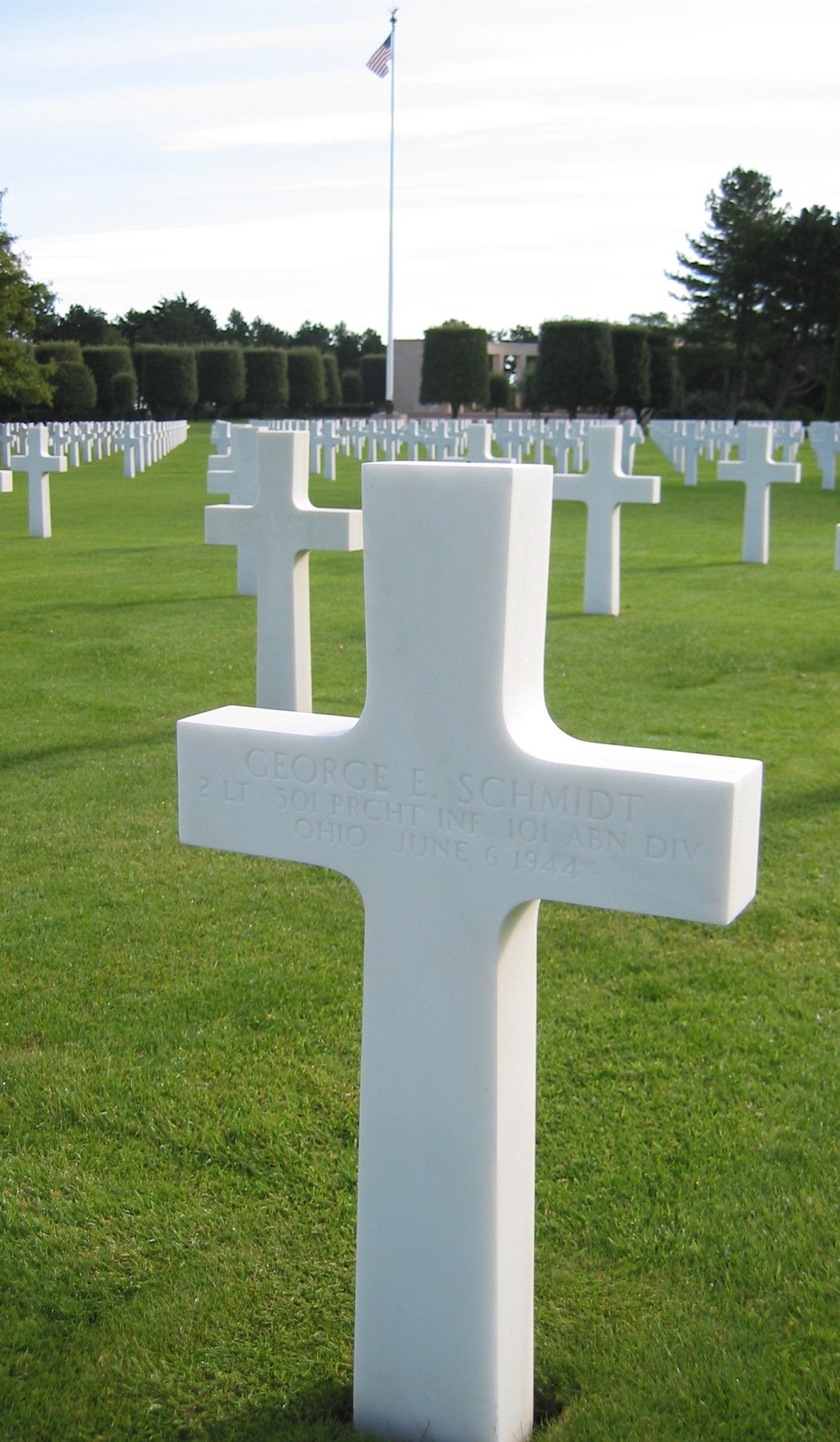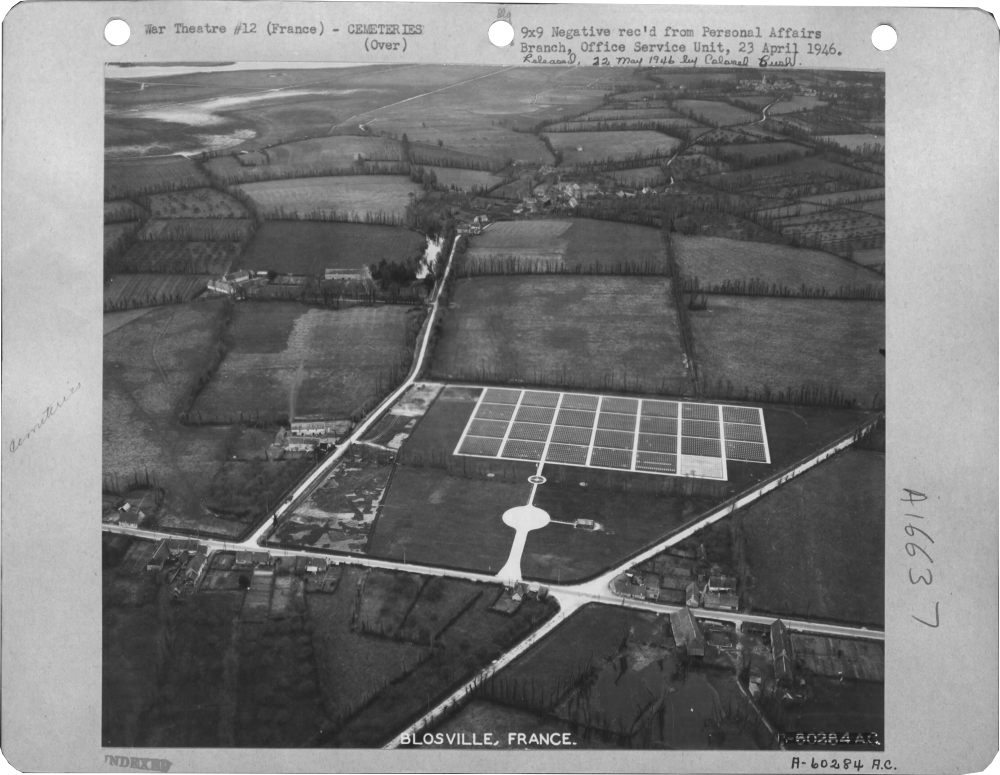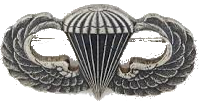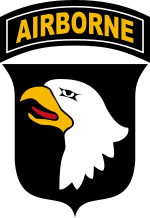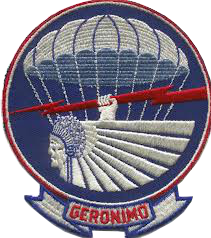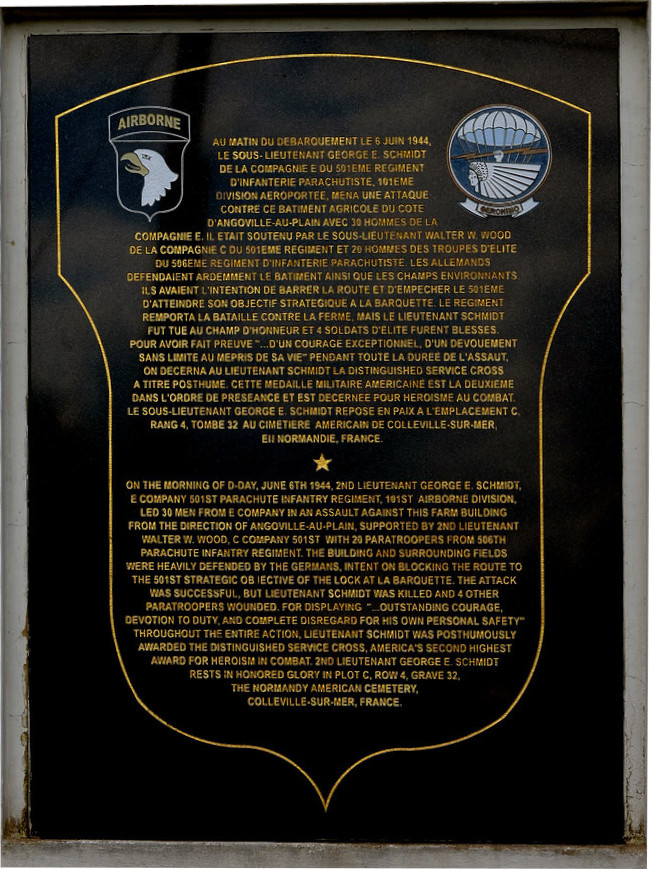|
George E. SCHMIDT
| ||||||||||||||||||||||||
|---|---|---|---|---|---|---|---|---|---|---|---|---|---|---|---|---|---|---|---|---|---|---|---|---|
|
Source : Collectif DIRR | ||||||||||||||||||||||||
| NUMBER OF SERVICE | O1303955 (35004454) | |||||||||||||||||||||||
| AGE | 31 yo | |||||||||||||||||||||||
| DATE OF BIRTH | 1913 Franklin OHIO | |||||||||||||||||||||||
| ENLISTMENT STATE | OHIO | |||||||||||||||||||||||
| FAMILY |
Single Parents : George Michael & Anna Margaret Becker SCHMIDT Siblings : Robert G & Carolina E. | |||||||||||||||||||||||
| RANK | Second Lieutenant | |||||||||||||||||||||||
| FONCTION | Paratrooper | |||||||||||||||||||||||
| JOB BEFORE ENLISTEMENT | Semiskilled linemen and servicemen, telegraph, telephone, and power |  | ||||||||||||||||||||||
| DATE of ENLISTEMENT | 10 March 1941 Fort Hayes Columbus OHIO | |||||||||||||||||||||||
| COMPANY | Company E | |||||||||||||||||||||||
| REGIMENT | 501st Parachute Infantry Regiment | |||||||||||||||||||||||
| DIVISION | 101st Airborne Division | |||||||||||||||||||||||
| DATE OF DEATH | 6 June 1944 |
Source : Jeff Kregel | ||||||||||||||||||||||
| STATUS | KIA | |||||||||||||||||||||||
| PLACE OF DEATH | Les Droueries - Angoville au plain | |||||||||||||||||||||||
| CEMETERY TEMPORARY | CEMTERY TEMPORARY of Hiesville | |||||||||||||||||||||||
|
CEMTERY TEMPORARY of Blosville N°3508
| ||||||||||||||||||||||||
| CEMETERY | NORMANDY AMERICAN CEMETERY of Colleville | |||||||||||||||||||||||
| GRAVE |
| |||||||||||||||||||||||
| DECORATION |
| |||||||||||||||||||||||
| ||||||||||||||||||||||||
| STORY | ||||||||||||||||||||||||
|
On D-Day morning, Second Lieutenant George E. Schmidt and 30 men from E Compagny lead an attack on the farm. Schmidt records the support of second lieutenant Walter W. Wood of the C Compagny and 20 men of the 506th PIR. However the Germans are ambushed in the farm and the surrounding fields in order to block the road to the Americans. The paratroopers won the battle, however 4 soldiers were wounded and Second Lieutenant Schmidt died there. |
Source : Flickr.com | |||||||||||||||||||||||
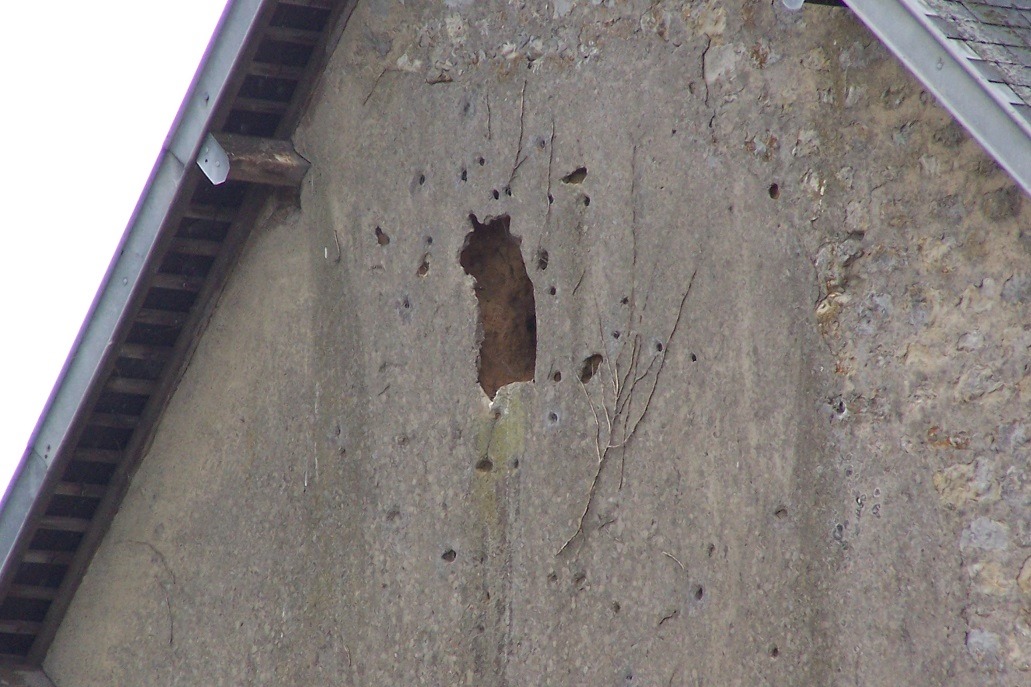 | 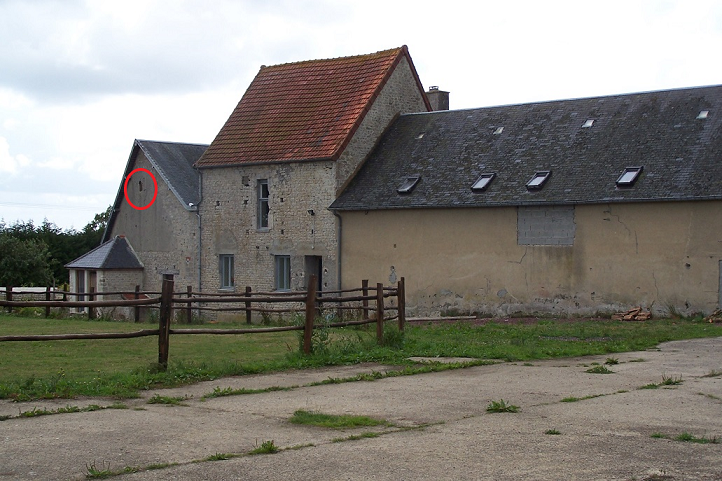 | |||||||||||||||||||||||
|
Location of the German sniper and the splinters made by the American paras to neutralize it Source: Bruno Cadeville | ||||||||||||||||||||||||
|
For his courage on the boat, he received posthumously the Distinguished Service Cross. Following this loss, the Germans pounded the position. In order to silence enemy ambitions, the cruiser USS Quincy, which anchors off Utah Beach, successfully bombs German artillery based in Saint-Côme-du-Mont. Finally on June 7, the German troops fell back definitively on Carentan. | ||||||||||||||||||||||||
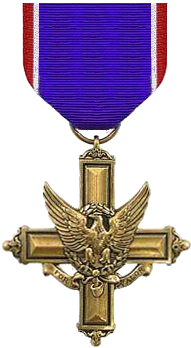 |
Distinguished Service Cross citationThe President of the United States of America, authorized by Act of Congress July 9, 1918, takes pride in presenting the Distinguished Service Cross (Posthumously) to Second Lieutenant (Infantry) George E. Schmidt (ASN: 0-1303955), United States Army, for extraordinary heroism in connection with military operations against an armed enemy while serving with Company E, 2nd Battalion, 501st Parachute Infantry Regiment, 101st Airborne Division, in action against enemy forces on 6 June 1944, in France. Second Lieutenant Schmidt landed by parachute with his battalion in the vicinity of St. Come-du-Mont, France. Due to a heavy concentration of machine gun and mortar fire from nearby enemy positions, the battalion had much difficulty in assembling but Second Lieutenant Schmidt, the first officer from his company to reach the assembly area, immediately assumed command and made repeated trips to the drop zone to bring back men and equipment. By his continuous and diligent efforts, he was successful in assembling an effective fighting force. Second Lieutenant Schmidt then skillfully deployed his men along the route of advance. Extremely heavy enemy fire suddenly pinned down the entire battalion. Second Lieutenant Schmidt, displaying outstanding leadership, placed his men in advantageous positions and ordered them to maintain a fast rate of fire in order to deceive the enemy as to the strength of his force. In an attempt to locate enemy snipers who were firing on his men, he exposed himself to enemy fire. Although he received a head wound he continued to search until he had spotted the snipers. While directing fire of his own machine gun upon these snipers, he was wounded. During the entire action he displayed outstanding courage, devotion to duty, and complete disregard for his personal safety. His conduct was in keeping with the highest traditions of the military forces of the United States and reflect great credit upon himself, the 101st Airborne Division, and the United States Army. | |||||||||||||||||||||||
Activated/Activé |
Normandy/Normandie |
| 15 Aug 1942 | Days of Combat/Jour de Combat 214 |
| Casualties/Victimes 9 328 | |
Entered Combat/Entré au combat |
|
| 6 Jun1944 D-Day | |
|
Commanding Generals/Commandants généraux Maj. Gen. William C. Lee (Aug 42 - Mar 44) |
Campaigns/CampagnesNormandy (6 Jun 44 - 24 Jul 44) Rhineland (15 Sep 44 - 21 Mar 45)
|
PLAN DE ROUTE DE LA CAMPAGNE - CAMPAIGN ROUTE MAP |
|
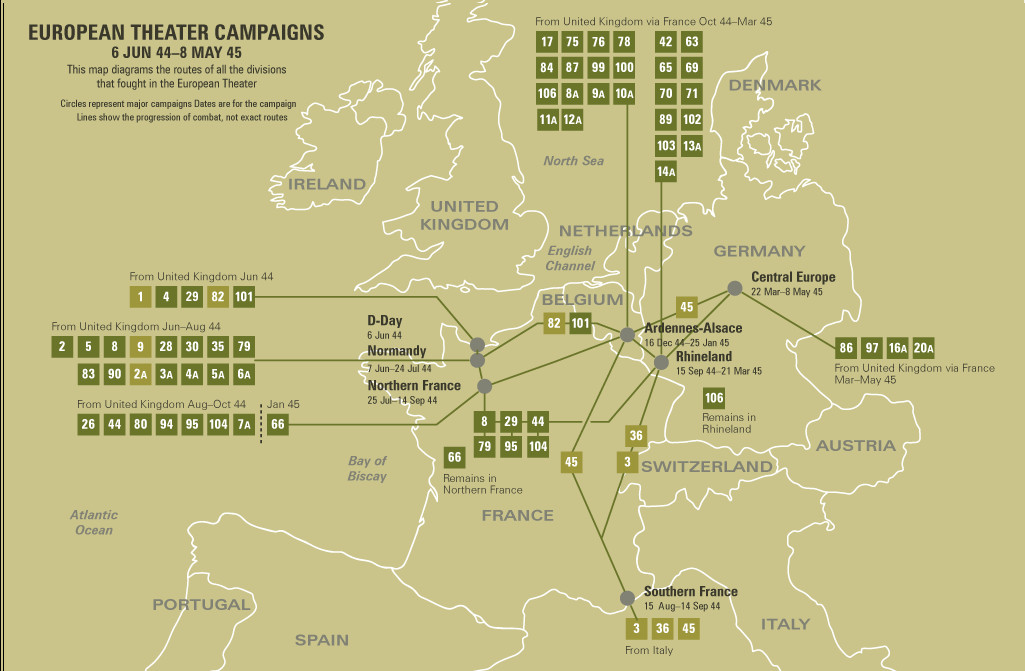 |
|
DIVISION CHRONICLEThe 101st Airborne arrived in England, 15 September 1943, and received additional training in Berkshire and Wiltshire. On 6 June 1944, the Division was dropped into Normandy behind Utah Beach. Against fierce resistance it took Pouppeville, Vierville, and St. Come du Mont. On the 12th, the stronghold of Carentan fell, and after mopping up and maintaining its positions, the Division returned to England, 13 July, for rest and training. On 17 September 1944, taking part in one of the largest of airborne invasions, the 101st landed in Holland, took Vechel and held the Zon bridge. St. Oedenrode and Eindhoven fell after sharp fighting on the 17th and 18th. Opheusden changed hands in a shifting struggle, but the enemy was finally forced to withdraw, 9 October. After extensive patrols, the Division returned to France, 28 November, for further training. On 18 December, it moved to Belgium to stop the German breakthrough. Moving into Bastogne under the acting command of Brig. Gen. Anthony C. McAuliffe, it set up a circular defense and although completely surrounded, refused to surrender on 22 December. Its perimeter held against violent attacks. The 4th Armored Division finally reached the 101st on the 26th and the enemy offensive was blunted. Very heavy fighting continued near Bastogne for the rest of December and January. On 17 January 1945, the Division moved to Drulingen and Pfaffenhoffen in Alsace and engaged in defensive harassing patrols along the Moder River. On 31 January, it crossed the Moder in a three-company raid. After assembling at Mourmelon, France, 26 February 1945, for training, it moved to the Ruhr pocket, 31 March, patrolling and raiding in April and engaging in military government at Rheydt and Munchen-Gladbach. The 101st reached Berchtesgaden by the end of the war and performed occupational duties until inactivation in Germany. |
CHRONIQUE DE DIVISIONLe 101st Airborne est arrivé en Angleterre, le 15 septembre 1943, et a reçu une formation supplémentaire dans le Berkshire et le Wiltshire. Le 6 juin 1944, la division est larguée en Normandie derrière Utah Beach. Contre une résistance féroce, il fallut Pouppeville, Vierville et St. Come du Mont. Le 12, le fief de Carentan est tombé, et après avoir nettoyé et maintenu ses positions, la Division est revenue en Angleterre, le 13 juillet, pour se reposer et s'entraîner. Le 17 septembre 1944, participant à l'une des plus grandes invasions aéroportées, la 101st débarque en Hollande, prend Vechel et tient le pont de Zon. St. Oedenrode et Eindhoven sont tombés après des combats acharnés les 17 et 18. Opheusden a changé de mains dans une lutte changeante, mais l'ennemi a finalement été forcé de se retirer, le 9 octobre. Après de longues patrouilles, la Division revint en France le 28 novembre pour suivre une formation complémentaire. Le 18 décembre, il a déménagé en Belgique pour arrêter la percée allemande. Déménagement à Bastogne sous le commandement de Brig. Général Anthony C. McAuliffe, il a mis en place une défense circulaire et bien que complètement encerclé, a refusé de se rendre le 22 décembre. Son périmètre tenu contre les attaques violentes. La 4e division blindée atteignit finalement la 101e le 26 et l'offensive ennemie fut émoussée. De très violents combats ont continué près de Bastogne pour le reste de décembre et janvier. Le 17 janvier 1945, la division s'est déplacée à Drulingen et à Pfaffenhoffen en Alsace et s'est livrée à des patrouilles de harcèlement défensif le long de la rivière Moder. Le 31 janvier, il a traversé le Moder dans un raid de trois compagnies. Après s'être rassemblé à Mourmelon, France, le 26 février 1945, pour s'entraîner, il s'installa dans la poche de la Ruhr, le 31 mars, patrouillant et faisant des raids en avril et s'engageant dans un gouvernement militaire à Rheydt et Munchen-Gladbach. La 101e a atteint Berchtesgaden à la fin de la guerre et a exercé des fonctions professionnelles jusqu'à l'inactivation en Allemagne. |
| SOURCE INFORMATION & PHOTO | Armydivs.squarespace.com |
|---|
| SOURCE INFORMATION & SOURCE PHOTO | Abmc.gov - Findagrave.com - Aad.archives.gov - Time To Go Home - Denis Van Den Brink |
|---|---|
| PROGRAMMER | Henri, Garrett, Clive, Frédéric & Renaud |


